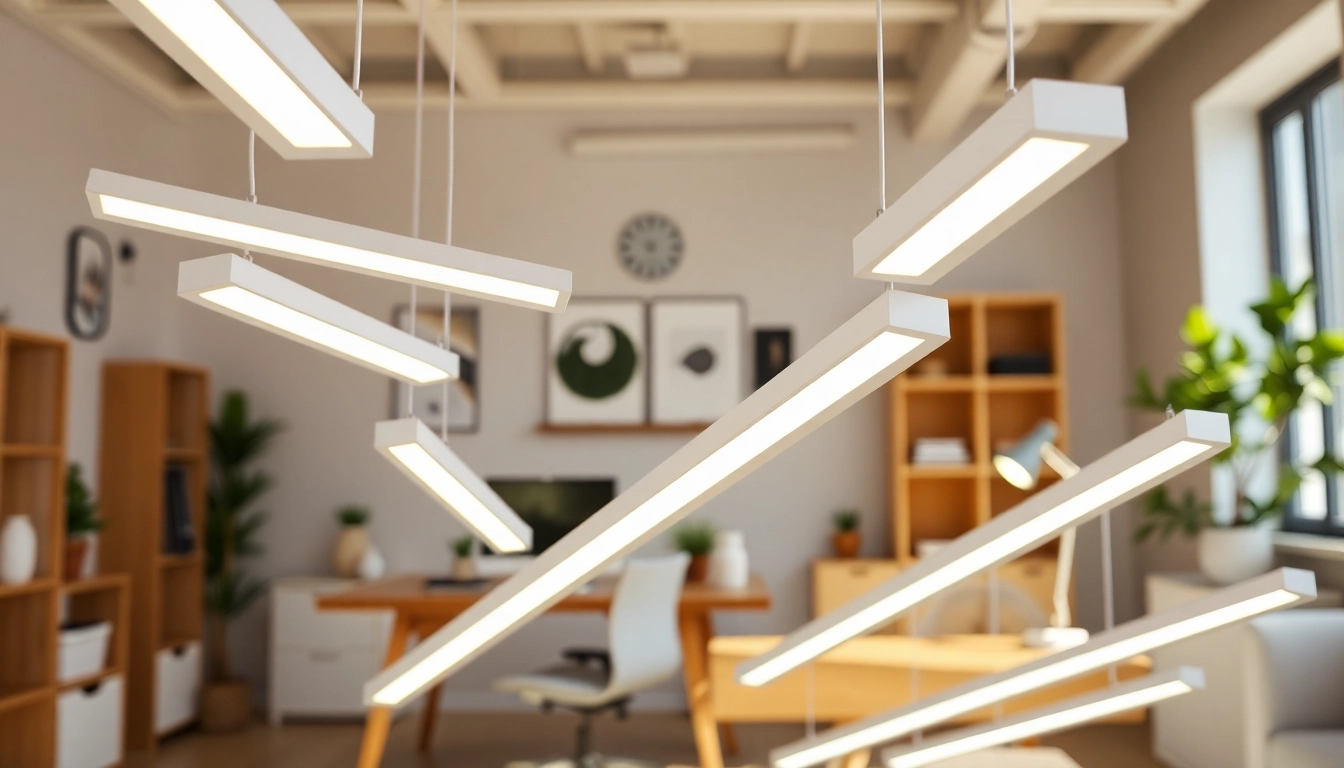Understanding LED Batten Lights
What are LED Batten Lights?
LED batten lights are a type of linear lighting solution designed for various applications, including residential, commercial, and industrial spaces. These lights utilize Light Emitting Diode (LED) technology, which has gained popularity due to its energy efficiency, longevity, and low maintenance requirements. Featuring a sleek and streamlined design, LED batten lights are available in different lengths and configurations, making them versatile for various lighting needs.
Typically mounted on walls or ceilings, LED batten lights can illuminate large areas effectively, providing powerful light output while consuming minimal energy. Their robust construction ensures durability, allowing them to withstand different environmental conditions, making them suitable for both indoor and outdoor applications.
Benefits of LED Batten Lights
The benefits of incorporating LED batten lights into your lighting solution are extensive and noteworthy:
- Energy Efficiency: LED technology is significantly more energy-efficient than traditional lighting solutions like fluorescent or incandescent bulbs. This efficiency translates to lower electricity bills and a reduced carbon footprint.
- Longevity: LED batten lights have a lifespan of up to 50,000 hours or more, which means they require less frequent replacements compared to other lighting types, saving time and costs on maintenance and replacements.
- Low Heat Emission: Unlike conventional lighting, LED batten lights generate minimal heat, reducing the risk of overheating and making them safer to operate, especially in enclosed spaces.
- Quality of Light: LED batten lights provide high-quality illumination with superior color rendering capabilities, enhancing visibility and aesthetics in any space.
- Flexibility: Available in various sizes, shapes, and brightness levels, LED batten lights offer flexibility in design, allowing for creative and customized lighting arrangements that meet specific user requirements.
- Sustainability: As LED lights are free from harmful substances like mercury, they present a more environmentally friendly lighting option, promoting sustainability and safety.
How LED Batten Lights Work
Understanding how LED batten lights operate requires a look at the technology behind LED. LEDs function by passing an electrical current through a semiconductor material, emitting light in the process. Unlike incandescent bulbs that convert energy into heat and light, LEDs are designed to produce light more directly, thereby minimizing energy loss.
The construction of LED batten lights consists of numerous LEDs arranged in a linear format within a housing that often includes a diffuser. This design serves to soften the light, distribute it evenly across a space, and reduce glare. Furthermore, many LED batten lights come equipped with controls for dimming, color temperature adjustments, or even smart features that allow for integration with home or commercial automation systems.
Choosing an LED Batten Light Manufacturer
Factors to Consider in Selection
When selecting an LED Batten Light Manufacturer, it’s essential to evaluate several key factors to ensure you partner with a reputable supplier:
- Experience and Reputation: A manufacturer with a strong track record typically has experience in producing high-quality products. Research their years in business, client testimonials, and case studies that demonstrate their credibility.
- Product Range: A diverse product range indicates a manufacturer capable of meeting various customer needs. Look for a provider that offers different models, sizes, color temperatures, and features to satisfy your specific requirements.
- Customization Options: If you have unique lighting needs, consider whether the manufacturer offers customization options. This flexibility can be invaluable in achieving the desired outcome for your projects.
- Manufacturing Standards: Verify that the manufacturer adheres to local and international quality control standards, including ISO certifications or compliance with safety regulations, which are critical for ensuring product reliability.
- Customer Service: Excellent customer service is indicative of a manufacturer’s commitment to its clients. Evaluate their responsiveness, technical support availability, and after-sales services.
Evaluating Quality and Performance
Quality and performance can make all the difference in any lighting solution. To evaluate the quality of LED batten lights, consider the following aspects:
- Materials: Inspect the materials used in manufacturing the batten lights. High-quality housing materials like aluminum or polycarbonate contribute to durability while also aiding in heat dissipation.
- LED Chips: Not all LED chips are created equal. Research the brands and grades of LED chips used by the manufacturer, as superior-quality chips yield better performance and longer lifespans.
- Lumen Output: Assess the lumen output of the batten lights, which indicates the brightness level. This measurement is crucial in determining whether the lights meet your lighting needs effectively.
- Color Rendering Index (CRI): A higher CRI (90 and above) ensures more accurate color representation, which is especially important in workplaces where color is critical.
- Warranty and Quality Assurance: A manufacturer that offers a strong warranty showcases confidence in its product’s quality. Look for comprehensive warranty coverage that demonstrates commitment to customer satisfaction.
Importance of Warranty and Support
The importance of warranty and technical support cannot be overstated when choosing an LED batten light manufacturer. A well-defined warranty provides peace of mind, allowing you to select products without concern for defects or malfunctions.
Consider how long the warranty period lasts and the specific conditions included. Is it a hassle-free replacement warranty, or are there limitations? Furthermore, assess the manufacturer’s support channels, including response times and availability. Good aftersales support can greatly enhance your overall experience, especially if you encounter any issues during installation or usage.
Incorporating LED Batten Lights into Your Space
Design Considerations for Home and Office
Designing effective lighting layouts with LED batten lights requires an understanding of the specific needs of the space. Here are key design considerations:
- Functionality: Determine the primary functions of the space. For example, offices may require bright and focused lighting for workspaces, while living areas might benefit from softer, ambient lighting.
- Placement: Strategically placing LED batten lights can enhance their effectiveness. Aim to position lights at equal intervals to prevent dark spots while ensuring coverage over task areas.
- Aesthetics: Consider how the linear design of batten lights fits within the overall decor. Whether you’re going for a modern, minimalist look or something more traditional, selecting the right finish and color can contribute significantly to the interior design.
- Brightness Levels: Adjust the brightness according to the function of the space. For example, task-oriented areas should have higher lumen output, while relaxation areas may call for dimmer settings.
- Color Temperature: Choose the suitable color temperature (measured in Kelvin) to set the mood. Warmer temperatures (2700K-3000K) are ideal for cozy areas, while cooler temperatures (4000K-5000K) are better for work and reading environments.
Installation Guidelines for LED Batten Lights
Proper installation of LED batten lights is essential to maximize their benefits and ensure safety. Here are some guidelines to follow:
- Safety First: Always ensure the power is disconnected before starting the installation. Use appropriate personal protective equipment (PPE) such as gloves and goggles.
- Read the Instructions: Manufacturers typically provide detailed installation manuals. Follow their guidelines carefully for optimal positioning and installation methods.
- Mounting Height: Consider the optimal mounting height for illumination. The standard height for batten lights in commercial spaces is usually around 2.4 to 3.0 meters from the floor for even distribution of light.
- Wiring Connections: Ensure all electrical connections are tight and secure to prevent hazards. Properly follow local electrical codes and regulations during this process.
- Testing: After installation, conduct a thorough test of the lights to ensure functionality. Check for even distribution of light and address any areas that may require adjustments.
Common Mistakes to Avoid
While incorporating LED batten lights, it’s crucial to be mindful of common pitfalls that may undermine your lighting project’s success:
- Overlapping Light Sources: Installing multiple light sources too close together can create unnecessary glare and shadows. Ensure appropriate spacing based on the lumen output and layout of your space.
- Ignoring Dimming Capabilities: Many LED batten lights come with dimming features. Failing to utilize these functions can lead to less than optimal lighting experiences throughout the day.
- Inconsistent Color Temperatures: Mixing batten lights with different color temperatures can result in unsettling lighting aesthetics. Aim for uniform color temperatures across your space.
- Neglecting Maintenance: Regular maintenance, such as dusting the fixtures and ensuring clear lenses, can prolong the life and efficiency of LED batten lights.
- Underestimating Brightness Needs: Failing to assess the specific brightness requirements for different areas can result in inadequate visibility. Use lumen calculations to ensure your lighting meets functional needs.
Cost and Energy Efficiency
Exploring Investment vs. Long-term Savings
When evaluating the cost implications of LED batten lights, it’s essential to balance initial investment with long-term savings. While LED batten lights often entail a higher upfront cost compared to traditional lighting solutions, their extended life and lower energy consumption can lead to significant savings over time.
For example, consider a space utilizing 10 traditional fluorescent lights versus 10 LED batten lights. The initial cost might be greater for the LEDs, but the energy savings accrued annually can be substantial, along with reduced maintenance costs. It’s vital to perform a detailed cost-benefit analysis to determine the overall value in transitioning to LED technology.
Understanding Energy Ratings and Certifications
Energy efficiency is a crucial aspect to consider when selecting LED batten lights. Understanding energy ratings, such as the Energy Star label, can help you identify products recognized for their energy-saving capabilities.
These ratings signify adherence to certain performance criteria set by governing bodies, emphasizing sustainability and efficiency. Additionally, look for relevant certifications such as CE or RoHS, which assure that the product meets safety and environmental standards.
Calculating Return on Investment
Calculating the return on investment (ROI) for LED batten lights involves analyzing both the cost of installation and the anticipated savings. Start by factoring the total investment, including purchase costs, labor for installation, and additional materials needed. Next, estimate your monthly energy savings based on your typical usage patterns compared to your previous lighting system.
By creating a detailed projection of savings against your total investment, you can visualize when you will achieve a payback period, highlighting the long-term financial benefits of making the switch to energy-efficient LED batten lights.
Trends in LED Batten Light Manufacturing
Innovations in LED Technology
The LED lighting industry is rapidly evolving, with continuous innovation driving improvements in performance, efficiency, and functionality.
Recent advancements include tunable white technology, which allows users to adjust color temperatures based on preference or time of day, mimicking natural sunlight patterns. Enhanced smart lighting solutions enable scheduling, remote control, and energy monitoring, creating integrated systems that contribute to automated and responsive environments.
Sustainability in Product Design
Sustainability has become a focal point in LED batten light manufacturing. A growing number of manufacturers are prioritizing environmentally responsible practices, utilizing recyclable materials and reducing manufacturing waste.
Furthermore, energy-efficient design choices not only contribute to lower operational costs but also align with global sustainability goals. As consumers increasingly seek green products, manufacturers that prioritize sustainable design will stand out in the competitive landscape.
The Future of LED Batten Lights
As we advance, the future of LED batten lights looks promising, characterized by even greater energy-saving potential, enhanced functionality, and integration with smart technologies. The market is expected to witness continuous evolution as manufacturers adapt to changing consumer preferences and environmental regulations.
Moreover, the continued adoption of smart buildings will propel demand for versatile lighting solutions. As LED batten lights integrate with IoT (Internet of Things) systems, the potential for automated and energy-efficient lighting control becomes a reality, revolutionizing how we use illumination in our spaces.



